Genetic Attenuation of Paraoxonase 1 Activity Induces Proatherogenic Changes in Plasma Proteomes of Mice and Humans
Abstract
:1. Introduction
2. Materials and Methods
2.1. Participants
2.2. Mice and Diet
2.3. Blood Collection
2.4. Genotyping
2.5. PON1 Activity Assays
2.6. Label-Free Mass Spectrometry
2.7. Data Analysis
2.8. Statistics
2.9. Bioinformatics Analysis
3. Results
3.1. Plasma Proteins Affected by Pon1 Genotype in Mice
3.2. Plasma Proteins Affected by PON1-Q192R Polymorphism in Humans
3.3. Overlap between Proteins Affected by PON1 Genotype in Humans and Mice
3.4. Bioinformatics Analysis
3.5. Human PON1-Q192R Polymorphism
3.6. Pon1−/− Mouse Genotype
4. Discussion
5. Conclusions
Supplementary Materials
Author Contributions
Funding
Conflicts of Interest
References
- Lewington, S.; Whitlock, G.; Clarke, R.; Sherliker, P.; Emberson, J.; Halsey, J.; Qizilbash, N.; Peto, R.; Collins, R. Blood cholesterol and vascular mortality by age, sex, and blood pressure: A meta-analysis of individual data from 61 prospective studies with 55 000 vascular deaths. Lancet 2007, 370, 1829–1839. [Google Scholar]
- Mackness, M.; Mackness, B. Paraoxonase 1 and atherosclerosis: Is the gene or the protein more important? Free. Radic. Biol. Med. 2004, 37, 1317–1323. [Google Scholar] [CrossRef] [PubMed]
- Durrington, P.N.; Mackness, B.; Mackness, M.I. Paraoxonase and Atherosclerosis. Arter. Thromb. Vasc. Biol. 2001, 21, 473480. [Google Scholar] [CrossRef] [PubMed] [Green Version]
- Costa, L.G.; Cole, T.B.; Jarvik, G.P.; Furlong, C.E. Functional genomic of the paraoxonase (PON1) polymorphisms: Effects on pesticide sensitivity, cardiovascular disease, and drug metabolism. Annu. Rev. Med. 2003, 54, 371–392. [Google Scholar] [CrossRef] [PubMed]
- Loscalzo, J. Paraoxonase and coronary heart disease risk: Language misleads, linkage misinforms, function clarifies. Circ. Cardiovasc Genet. 2008, 1, 79–80. [Google Scholar] [CrossRef] [Green Version]
- Jakubowski, H. Calcium-dependent Human Serum Homocysteine Thiolactone Hydrolase. J. Biol. Chem. 2000, 275, 3957–3962. [Google Scholar] [CrossRef] [Green Version]
- Jakubowski, H. Homocysteine Modification in Protein Structure/Function and Human Disease. Physiol. Rev. 2019, 99, 555–604. [Google Scholar] [CrossRef]
- Borowczyk, K.; Piechocka, J.; Głowacki, R.; Dhar, I.; Midtun, Ø.; Tell, G.S.; Ueland, P.M.; Nygård, O.; Jakubowski, H. Urinary excretion of homocysteine thiolactone and the risk of acute myocardial infarction in coronary artery disease patients: The WENBIT trial. J. Intern. Med. 2019, 285, 232–244. [Google Scholar] [CrossRef]
- Perla-Kajan, J.; Borowczyk, K.; Glowacki, R.; Nygard, O.; Jakubowski, H. Paraoxonase 1 Q192R genotype and activity affect homocysteine thiolactone levels in humans. FASEB J. Off. Publ. Fed. Am. Soc. Exp. Biol. 2018, 32, 6019–6024. [Google Scholar]
- Lacinski, M.; Skorupski, W.; Cieslinski, A.; Sokolowska, J.; Trzeciak, W.H.; Jakubowski, H. Determinants of homocysteine-thiolactonase activity of the paraoxonase-1 (PON1) protein in humans. Cell. Mol. Biol. 2004, 50, 885–893. [Google Scholar]
- Jakubowski, H.; Ambrosius, W.T.; Pratt, J. Genetic determinants of homocysteine thiolactonase activity in humans: Implications for atherosclerosis. FEBS Lett. 2001, 491, 35–39. [Google Scholar] [CrossRef] [Green Version]
- Mackness, M.; Mackness, B. Human paraoxonase-1 (PON1): Gene structure and expression, promiscuous activities and multiple physiological roles. Gene 2015, 567, 12–21. [Google Scholar] [CrossRef] [PubMed] [Green Version]
- Shih, D.M.; Gu, L.; Xia, Y.-R.; Navab, M.; Li, W.-F.; Hama, S.; Castellani, L.W.; Furlong, C.E.; Costa, L.G.; Fogelman, A.M.; et al. Mice lacking serum paraoxonase are susceptible to organophosphate toxicity and atherosclerosis. Nat. Cell Biol. 1998, 394, 284–287. [Google Scholar] [CrossRef] [PubMed]
- Shih, D.M.; Xia, Y.-R.; Wang, X.-P.; Miller, E.; Castellani, L.W.; Subbanagounder, G.; Cheroutre, H.; Faull, K.F.; Berliner, J.A.; Witztum, J.L.; et al. Combined Serum Paraoxonase Knockout/Apolipoprotein E Knockout Mice Exhibit Increased Lipoprotein Oxidation and Atherosclerosis. J. Biol. Chem. 2000, 275, 17527–17535. [Google Scholar] [CrossRef] [PubMed] [Green Version]
- Tward, A.; Xia, Y.-R.; Wang, X.-P.; Shi, Y.-S.; Park, C.; Castellani, L.W.; Lusis, A.J.; Shih, D.M. Decreased Atherosclerotic Lesion Formation in Human Serum Paraoxonase Transgenic Mice. Circulation 2002, 106, 484–490. [Google Scholar] [CrossRef] [PubMed] [Green Version]
- Bhattacharyya, T. Relationship of Paraoxonase 1 (PON1) Gene Polymorphisms and Functional Activity with Systemic Oxidative Stress and Cardiovascular Risk. JAMA 2008, 299, 1265–1276. [Google Scholar] [CrossRef] [PubMed] [Green Version]
- Kunutsor, S.K.; Bakker, S.J.; James, R.W.; Dullaart, R.P. Serum paraoxonase-1 activity and risk of incident cardiovascular disease: The PREVEND study and meta-analysis of prospective population studies. Atheroscler. 2016, 245, 143–154. [Google Scholar] [CrossRef] [Green Version]
- Menini, T.; Gugliucci, A. Paraoxonase 1 in neurological disorders. Redox Rep. 2014, 19, 49–58. [Google Scholar] [CrossRef]
- Li, H.; Wetten, S.; Li, L.; Jean, P.L.S.; Upmanyu, R.; Surh, L.; Hosford, D.; Barnes, M.R.; Briley, J.D.; Borrie, M.; et al. Candidate Single-Nucleotide Polymorphisms from a Genomewide Association Study of Alzheimer Disease. Arch. Neurol. 2008, 65, 45–53. [Google Scholar] [CrossRef] [Green Version]
- Erlich, P.M.; Lunetta, K.L.; Cupples, L.A.; Abraham, C.R.; Green, R.C.; Baldwin, C.T.; Farrer, L.A. Serum paraoxonase activity is associated with variants in the PON gene cluster and risk of Alzheimer disease. Neurobiol. Aging 2012, 33, 1015.e7–1015e23. [Google Scholar] [CrossRef] [Green Version]
- Bednarska-Makaruk, M.; Krzywkowski, T.; Graban, A.; Lipczyńska-Łojkowska, W.; Bochyńska, A.; Rodo, M.; Wehr, H.; Ryglewicz, D.K. Original article Paraoxonase 1 (PON1) gene -108C>T and p.Q192R polymorphisms and arylesterase activity of the enzyme in patients with dementia. Folia Neuropathol. 2013, 2, 111–119. [Google Scholar] [CrossRef] [PubMed]
- Borowczyk, K.; Shih, D.M.; Jakubowski, H. Metabolism and Neurotoxicity of Homocysteine Thiolactone in Mice: Evidence for a Protective Role of Paraoxonase 1. J. Alzheimer’s Dis. 2012, 30, 225–231. [Google Scholar] [CrossRef] [PubMed]
- Humbert, R.; Adler, D.A.; Disteche, C.M.; Hassett, C.; Omiecinski, C.J.; Furlong, C.E. The molecular basis of the human serum paraoxonase activity polymorphism. Nat. Genet. 1993, 3, 73–76. [Google Scholar] [CrossRef] [PubMed]
- Perla-Kajan, J.; Jakubowski, H. Paraoxonase 1 protects against protein N-homocysteinylation in humans. FASEB J. Off. Publ. Fed. Am. Soc. Exp. Biol. 2010, 24, 931–936. [Google Scholar] [CrossRef]
- Sikora, M.; Lewandowska, I.; Marczak, Ł.; Bretes, E.; Jakubowski, H. Cystathionine β-synthase deficiency: Different changes in proteomes of thrombosis-resistant Cbs−/− mice and thrombosis-prone CBS−/− humans. Sci. Rep. 2020, 10, 10726. [Google Scholar] [CrossRef]
- Ganfornina, M.D.; Carmo, S.D.; Lora, J.M.; Torres-Schumann, S.; Vogel, M.; Allhorn, M.; Gonzalez, C.; Bastiani, M.J.; Rassart, E.; Sanchez, D. Apolipoprotein D is involved in the mechanisms regulating protection from oxidative stress. Aging Cell 2008, 7, 506–515. [Google Scholar] [CrossRef] [Green Version]
- Elsøe, S.; Ahnström, J.; Christoffersen, C.; Hoofnagle, A.N.; Plomgaard, P.; Heinecke, J.W.; Binder, C.J.; Björkbacka, H.; Dahlbäck, B.; Nielsen, L.B. Apolipoprotein M binds oxidized phospholipids and increases the antioxidant effect of HDL. Atherosclerosis 2012, 221, 91–97. [Google Scholar] [CrossRef]
- Birch, N.P.; Browett, P.J.; Coughlin, P.B.; Horvath, A.J.; Van De Water, N.S.; Ockelford, P.A.; Harper, P.L.; Young, L.K. Two missense mutations identified in venous thrombosis patients impair the inhibitory function of the protein Z dependent protease inhibitor. Thromb. Haemost. 2012, 107, 854–863. [Google Scholar] [CrossRef]
- Muszbek, L.; Bereczky, Z.; Bagoly, Z.; Komáromi, I.; Katona, É. Factor XIII: A Coagulation Factor with Multiple Plasmatic and Cellular Functions. Physiol. Rev. 2011, 91, 931–972. [Google Scholar] [CrossRef] [Green Version]
- Pruissen, D.M.O.; Slooter, A.J.C.; Rosendaal, F.R.; Van Der Graaf, Y.; Algra, A. Coagulation factor XIII gene variation, oral contraceptives, and risk of ischemic stroke. Blood 2008, 111, 1282–1286. [Google Scholar] [CrossRef] [Green Version]
- Tang, W.H.W.; Hartiala, J.; Fan, Y.; Wu, Y.; Stewart, A.F.; Erdmann, J.; Kathiresan, S.; Roberts, R.; McPherson, R.; Allayee, H.; et al. Clinical and Genetic Association of Serum Paraoxonase and Arylesterase Activities with Cardiovascular Risk. Arter. Thromb. Vasc. Biol. 2012, 32, 2803–2812. [Google Scholar] [CrossRef] [PubMed] [Green Version]
- Suchon, P.; Trégouët, D.-A.; Morange, P.-E. Genetics of Venous Thrombosis: Update in 2015. Thromb. Haemost. 2015, 114, 910–919. [Google Scholar] [CrossRef] [PubMed]
- Unsworth, A.J.; Flora, G.D.; Sasikumar, P.; Bye, A.P.; Sage, T.; Kriek, N.; Crescente, M.; Gibbins, J.M. RXR Ligands Negatively Regulate Thrombosis and Hemostasis. Arter. Thromb. Vasc. Biol. 2017, 37, 812–822. [Google Scholar] [CrossRef] [PubMed] [Green Version]
- Suszyńska-Zajczyk, J.; Sikora, M.; Jakubowski, H. Paraoxonase 1 deficiency and hyperhomocysteinemia alter the expression of mouse kidney proteins involved in renal disease. Mol. Genet. Metab. 2014, 113, 200–206. [Google Scholar] [CrossRef] [PubMed]

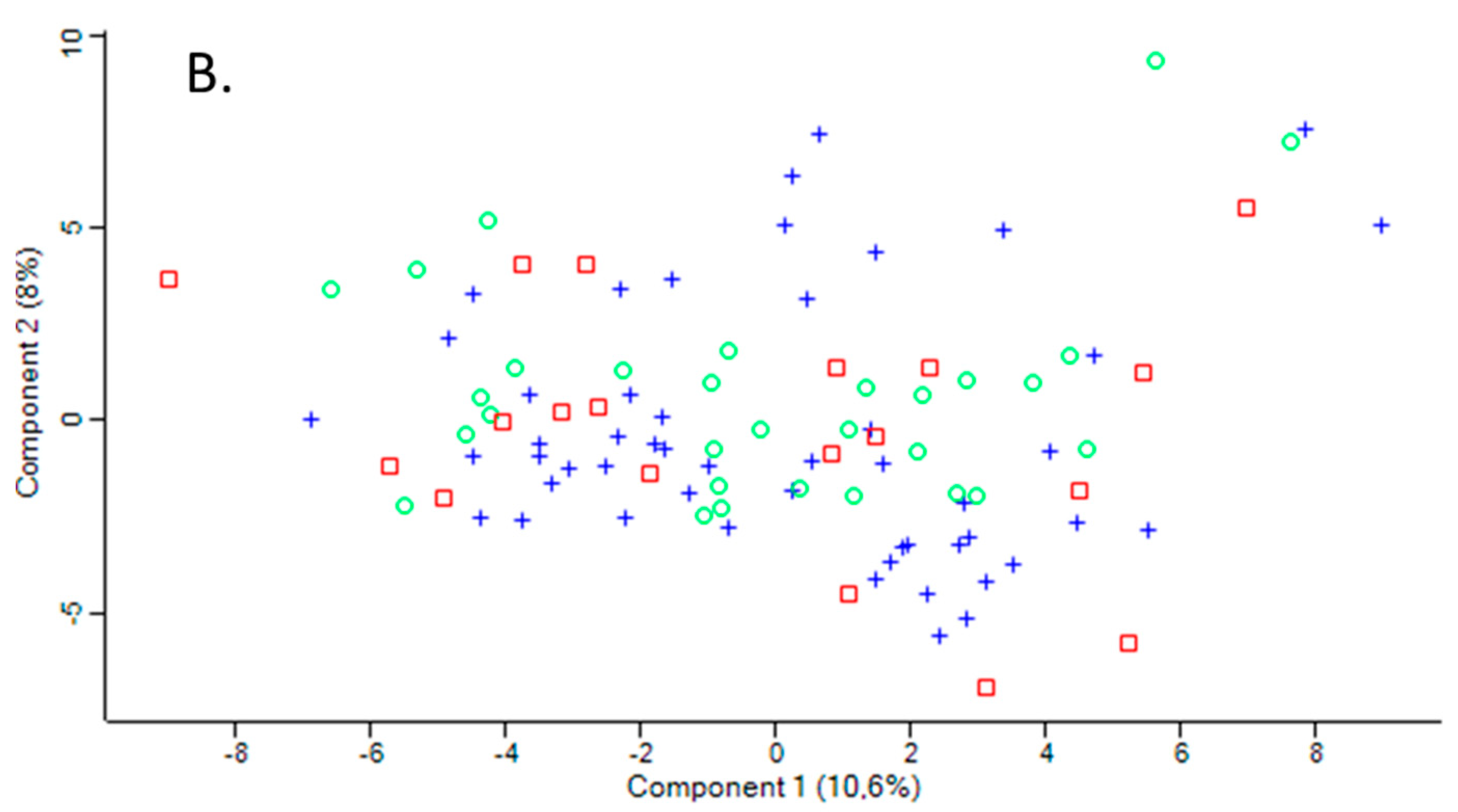
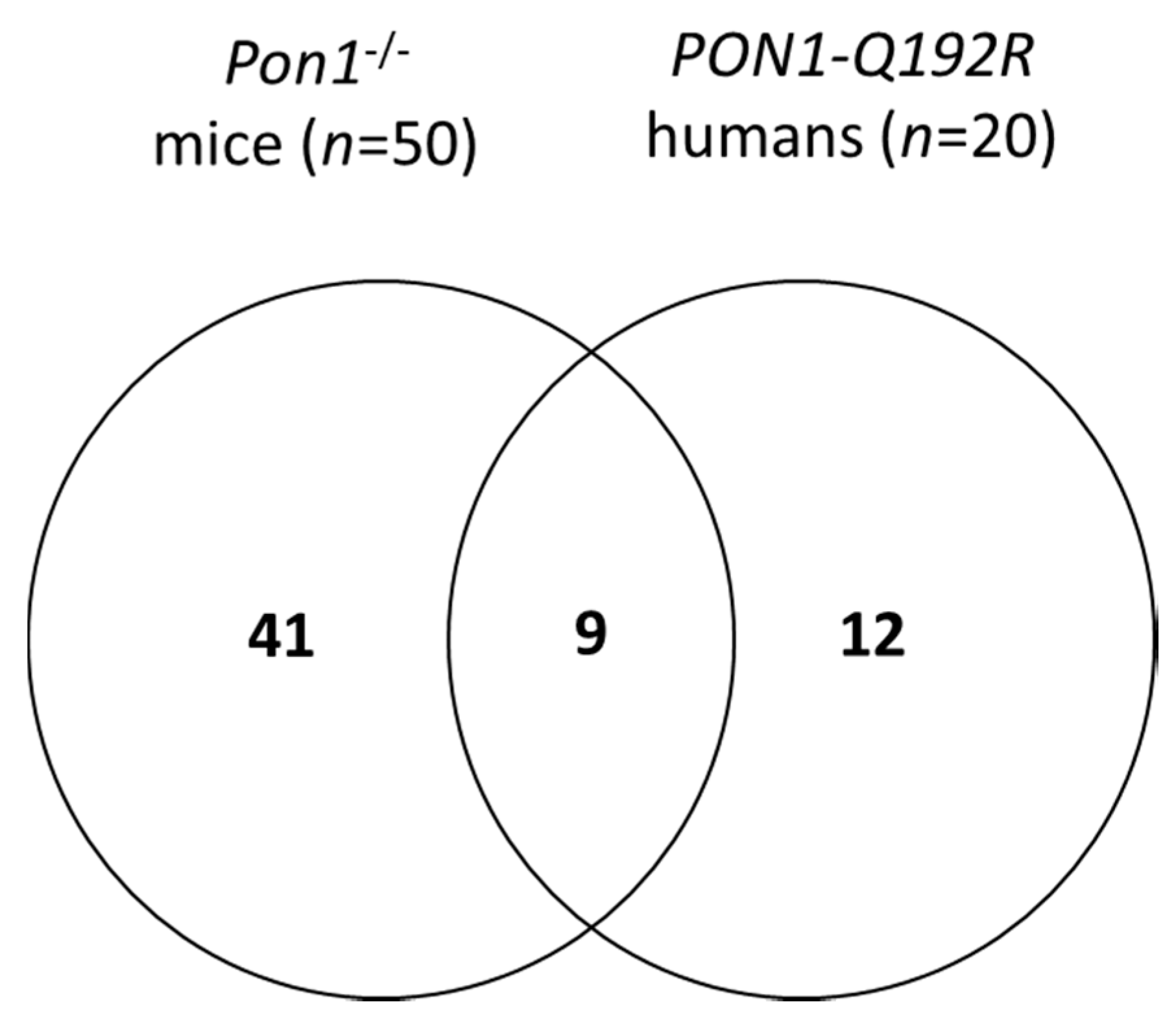
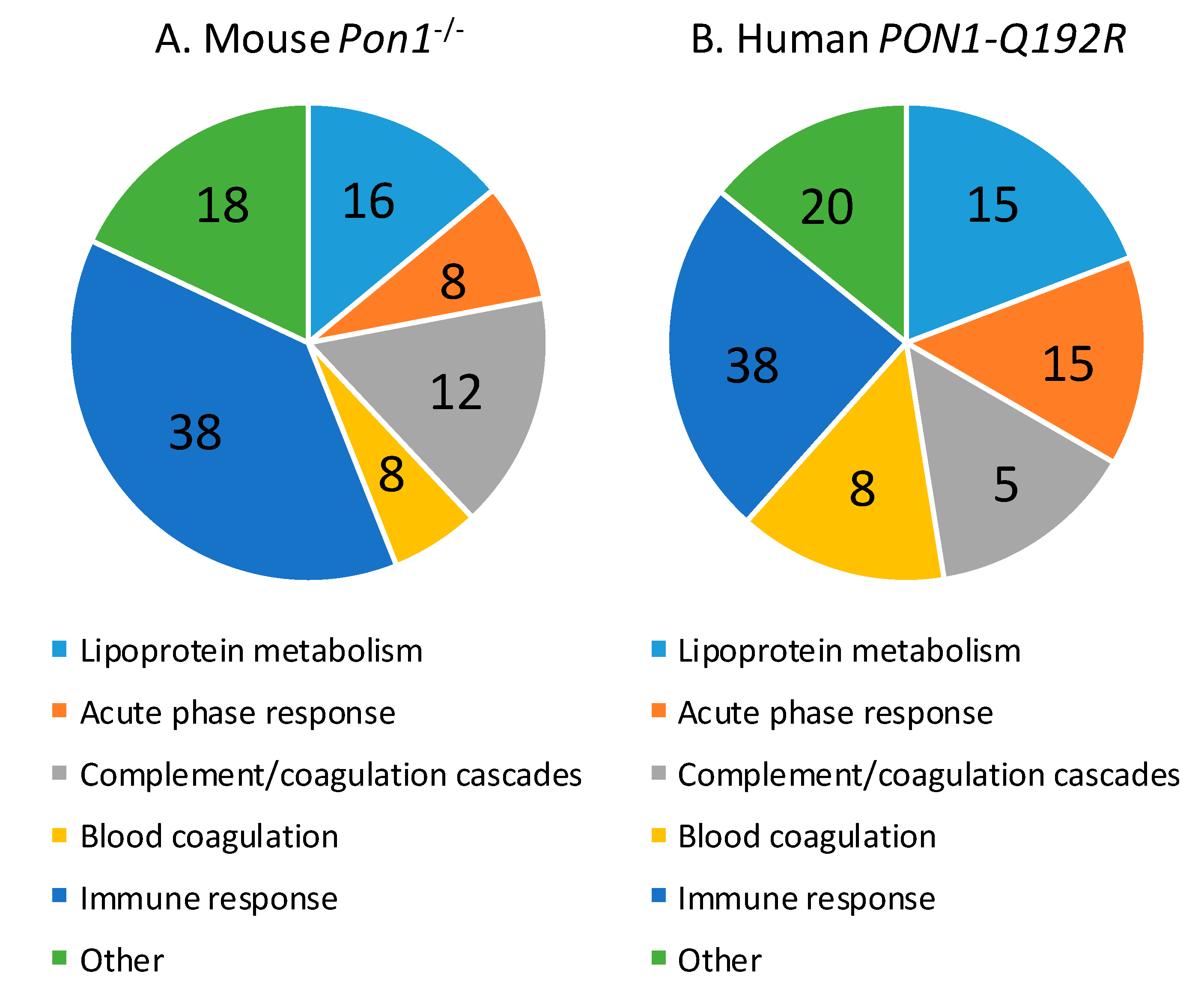
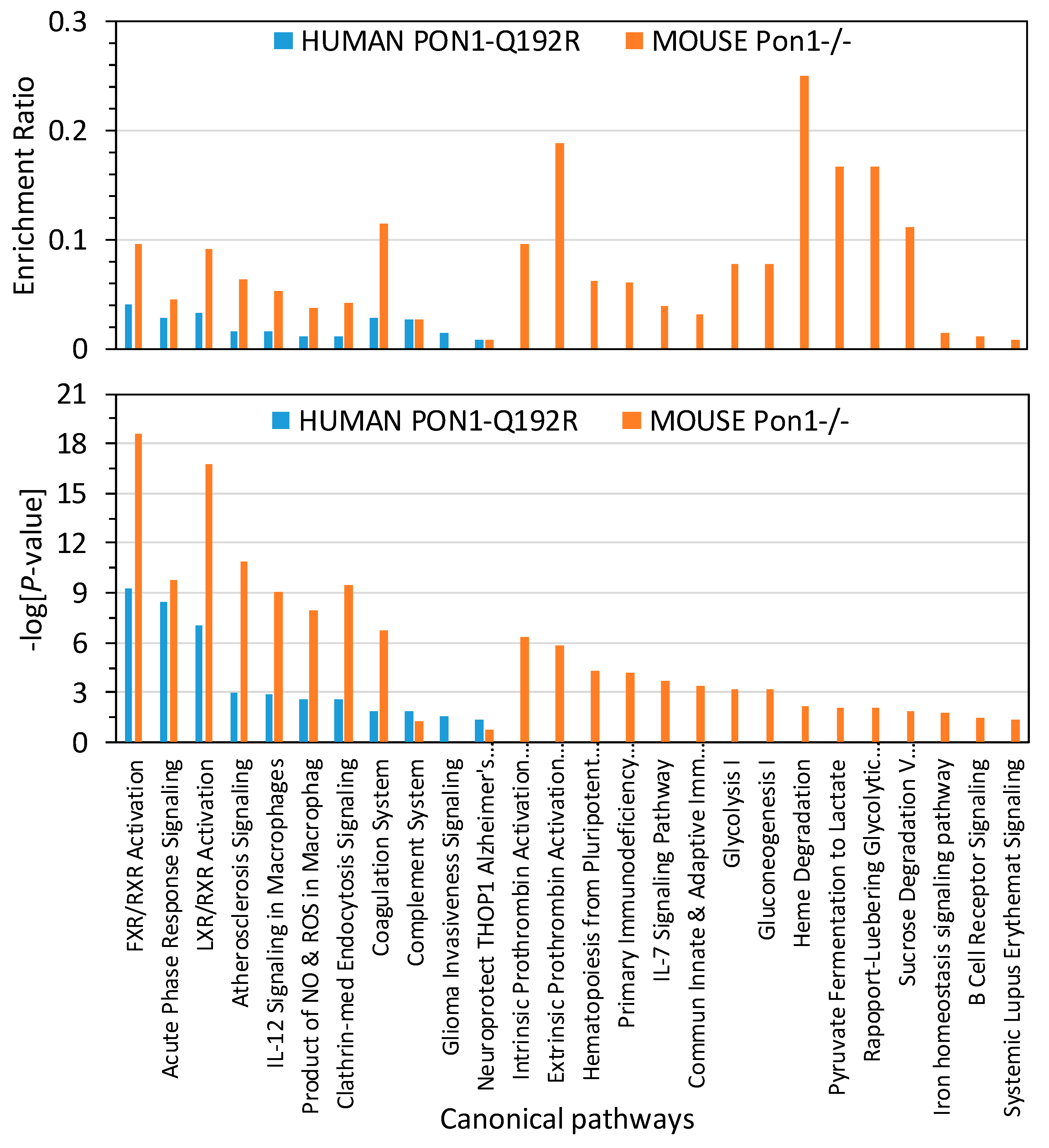


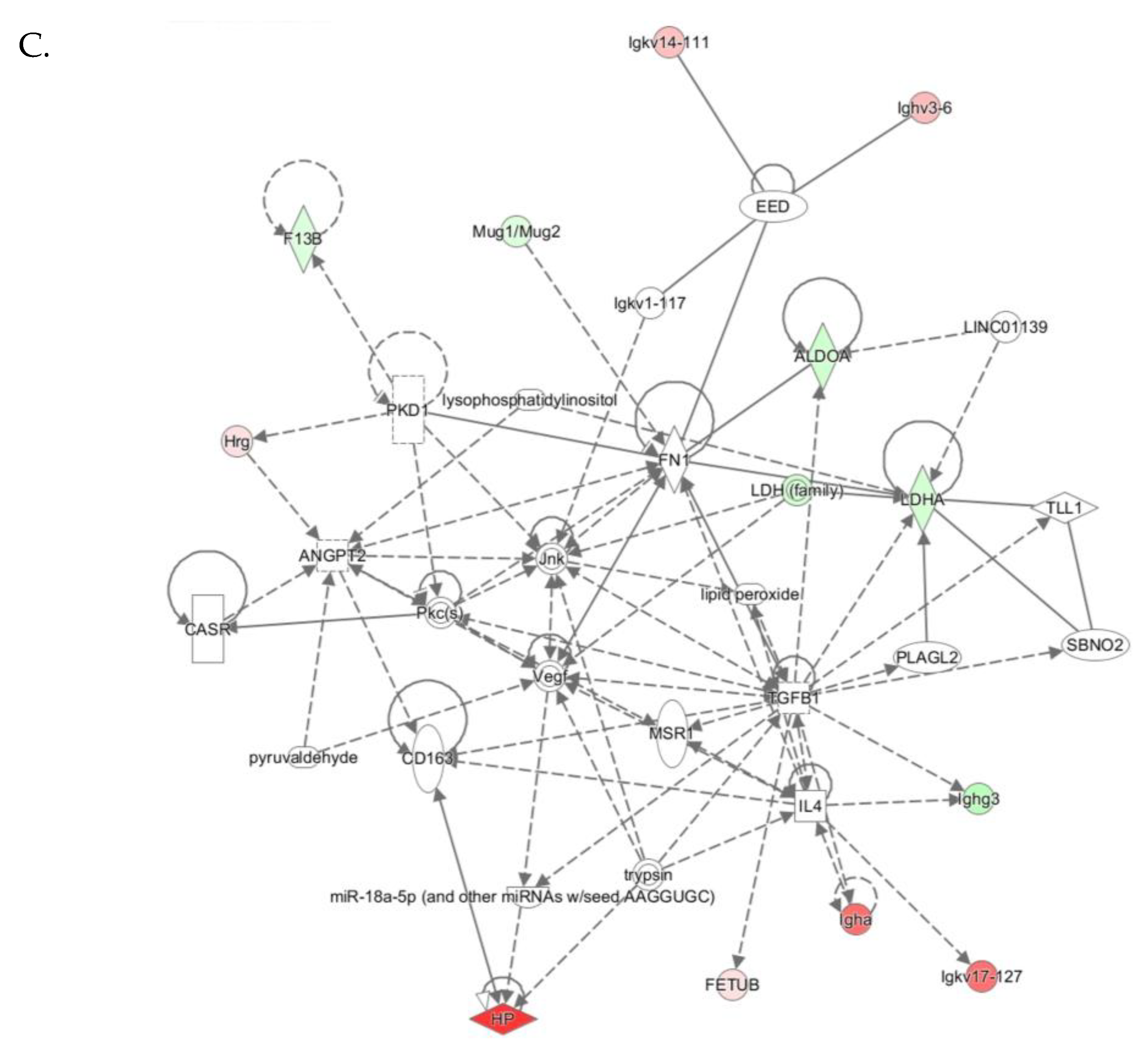
| Human Paraoxonase 1 | Mouse Paraoxonase 1 | ||||
|---|---|---|---|---|---|
| Genotype (n) | Activity a | Protein b | Genotype (n) | Activity a | Protein b |
| PON1-192RR (19) | 100 | 100 | Pon1+/+ (17) | 100 | 100 |
| PON1-192QR (30) | 20.6 | 63.0 | |||
| PON1-192QQ (51) | 14.3 | 60.0 | Pon1−/− (8) | 0.0 | 2.0 |
| Unique to Mice (n = 41) $ | Unique to Humans (n = 12) $ | Proteins Affected in Mice and Humans (n = 9) # | ||
|---|---|---|---|---|
| ↓Afm | ↓Blvrb | ↓Ldha | ↑GPX3 | |
| ↓Alb | ↓Bpgm | ↓Lifr | ↓RBP4 | |
| ↓Aldoa | ↓Ica | ↑Mug1 | ||
| Lipoprotein metabolism (n = 3): ↑ApoB, ↓ApoC1, ↑Lcat | Lipoprotein metabolism (n = 3): ↓APOA1↓, ↑APOD↑, ↑APOM↑, ↓PON1↓ | |||
| Acute phase response (n = 2): ↑Ambp, ↑Hpx | Acute phase response (n = 1): ↑ITIH3, | Acute phase response (n = 2): ↑HP↓, ↑TTR↓ | ||
| Blood coagulation (n = 2): ↑Hrg, ↓Itih1 | Blood coagulation (n = 3): ↓PLG, ↓SERPINA10, ↓VTN | Blood coagulation (n = 1): ↓F13B↓ | ||
| Complement/coagulation (n = 7): ↑Al182371, ↑Cfh, ↑Clu, ↑F2, ↓Klkb1, ↓Mbl1; ↓Serpinc1 | Complement/coagulation (n = 2): ↑C9, ↑V2-17 (IGL) | Complement/coagulation (n = 1): ↑FETUB↓ | ||
| Immune response (n =18): ↑Igh (n = 9), ↑Igj, ↑Igk (n = 6), ↑Igl (n = 2) | Immune response (n = 5): ↑CFP, ↓N/A, ↑PGLYRP2, ↑V2-6 (IGL), | Immune response (n = 1): ↓IGHG3↑ | ||
| Analysis | Molecules in Network | Score | Focus Molecules | Top Diseases and Functions |
|---|---|---|---|---|
| PON1-192QQ vs. QR+RR (Figure 5A) | 15-hydroxyeicosatetraenoic acid, 7-ketocholesterol, AMBP, APOA2, ascorbic acid, ↑C9, CD68, ↑CFP, Cu2, Fe2, ↓FETUB, FOS, GHRL, HDL, IL6, Immunoglobulin, ITIH1, ↑ITIH3, ITIH4, L-phenylalanine, LCAT, LDL, lipid peroxide, MSR1, palmitoleic acid, ↑PGLYRP2, ↓PLG, PLTP, ↓PON1, PON3, Rbp, ↓RBP4, TGFB1, ↓TTR, VLDL-cholesterol | 27 | 9 | Lipid Metabolism, Molecular Transport, Small Molecule Biochemistry |
| PON1-192QQ vs. QR | 15-hydroxyeicosatetraenoic acid, APCS, ↓APOA1, Apoc1, APOF, APOL1, ↓APOM, bilirubin, ↑C9, ↑CFP, Cxcl9, Fe2, Ferritin, ↓GPX3, Growth hormone, GSTT1, ↓HBB, HBD, HBG1, HBQ1, HDL, hemoglobin, ↓HPR, Immunoglobulin, Insulin, ITIH4, LDL, ↓PON1, PON3, Rbp, ↓RBP4, SAA2, SELENOT, ↓TTR, IGHV1-69, ↑IGLV3-9 | 28 | 11 | Lipid Metabolism, Molecular Transport, Small Molecule Biochemistry |
| PON1-192QQ vs. RR | 15-hydroxyeicosatetraenoic acid, AFM, Alpha 1 antitripsin, AMBP, C1QTNF3, CCR2, CD40LG, Cd64, CD68, CXADR, ↓F13B, FCGR2C, Fe2, IFNG, IgG3 kappa, IgG3 lambda, IGHG1, ↑IGHG3, IGHG4, ITIH1, ↑ITIH3, ITIH4, LCAT, lipid peroxide, MSR1, MTRR, palmitoleic acid, ↓PON1, PON3, RAD51AP1, ↓RBP4, ↓SERPINA10, TGFB1, TNFAIP6, VLDL-cholesterol | 18 | 6 | Lipid Metabolism, Molecular Transport, Small Molecule Biochemistry |
| PON1-192QR vs. RR (Figure 5B) | ALCAM, Alpha 1 antitrypsin, APOA2, APOA4, ↑APOD, Apolipoprotein, ↑APOM, arginine, C8G, C9, CD40LG, CLCN5, DUX4, F10, FAM20C, glutathione, glycosaminoglycan, GPX1, ↑GPX3, HDL, HMOX1, LCAT, LCN, NFE2L2, NFKBIA, NRG1, POU2F1, SEMA3F, ↓SERPINA10, SERPINC1, SREBF1, sulfatides, TFRC, UBQLN1, ↓VTN | 14 | 5 | Cardiovascular Disease, Neurological Disease, Organismal Injury and Abnormalities |
| Analysis | Molecules in Network | Score | Focus Molecules | Top Diseases and Functions |
|---|---|---|---|---|
| Pon1−/− vs. Pon1+/+Figure 6A | ↓ALB, ↑AMBP, ↓APOA1, ↑APOB, ↓Apoc1, ↑APOD, ↑APOM, ↑CFH, chymotrypsin, ↑CLU, ERK1/2, Ferritin, Fibrinogen, Growth hormone, HDL, HDL-cholesterol, hemoglobin, ↑HP, ↑HPX, ↓ITIH1, Kallikrein, ↓KLKB1, ↑LCAT, ↓Ldh (complex), LDL, LDL-cholesterol, MHC Class II (complex), Nr1h, ↓PON1, PRKAA, Pro-inflammatory Cytokine, ↓SERPINC1, Tcf 1/3/4, ↑TTR, VLDL-cholesterol | 41 | 17 | Lipid Metabolism, Molecular transport, Small Molecule Biochemistry |
| Pon1−/− vs. Pon1+/+Figure 6B | ↓AFM, Akt, Ap1, ↓BLVRB, ↓BPGM, cytokine, ERK, F2, GOT, ↓HGFAC, Iga, IgG, IgG1, IgG2a, IgG2b, Igg3, Igh (family), ↑Igha, IGHG1, ↑IGHM, ↑Iglv1, Igm, IL1, Immunoglobulin, Insulin, JCHAIN, ↓LIFR, MAP2K1/2, Mapk, ↓Mbl1, NFkB (complex), P38 MAPK, PI3K (complex), STAT, Tgf beta | 26 | 12 | Humoral Immune Response, Inflammatory Response, Protein Synthesis |
| Pon1−/− vs. Pon1+/+Figure 6C | ↓ALDOA, ANGPT2, CASR, CD163, EED, ↓F13B, ↑FETUB, FN1, ↑HP, ↑Hrg, ↑Igha, ↓Ighg3, ↑Ighv3-6, Igkv1-117, Igkv14-111, ↑Igkv17-127, IL4, Jnk, LDH (family), ↓LDHA, LINC01139, lipid peroxide, lysophosphatidylinositol, miR-18a-5p (and other miRNAs w/seed AAGGUGC), MSR1, Mug1/Mug2, Pkc(s), PKD1, PLAGL2, pyruvaldehyde, SBNO2, TGFB1, TLL1, trypsin, Vegf | 26 | 12 | Cell-to-Cell Signaling and Interaction, He- matological System Development and Function, Immune Cell Trafficking |
Publisher’s Note: MDPI stays neutral with regard to jurisdictional claims in published maps and institutional affiliations. |
© 2020 by the authors. Licensee MDPI, Basel, Switzerland. This article is an open access article distributed under the terms and conditions of the Creative Commons Attribution (CC BY) license (http://creativecommons.org/licenses/by/4.0/).
Share and Cite
Sikora, M.; Bretes, E.; Perła-Kaján, J.; Lewandowska, I.; Marczak, Ł.; Jakubowski, H. Genetic Attenuation of Paraoxonase 1 Activity Induces Proatherogenic Changes in Plasma Proteomes of Mice and Humans. Antioxidants 2020, 9, 1198. https://doi.org/10.3390/antiox9121198
Sikora M, Bretes E, Perła-Kaján J, Lewandowska I, Marczak Ł, Jakubowski H. Genetic Attenuation of Paraoxonase 1 Activity Induces Proatherogenic Changes in Plasma Proteomes of Mice and Humans. Antioxidants. 2020; 9(12):1198. https://doi.org/10.3390/antiox9121198
Chicago/Turabian StyleSikora, Marta, Ewa Bretes, Joanna Perła-Kaján, Izabela Lewandowska, Łukasz Marczak, and Hieronim Jakubowski. 2020. "Genetic Attenuation of Paraoxonase 1 Activity Induces Proatherogenic Changes in Plasma Proteomes of Mice and Humans" Antioxidants 9, no. 12: 1198. https://doi.org/10.3390/antiox9121198






